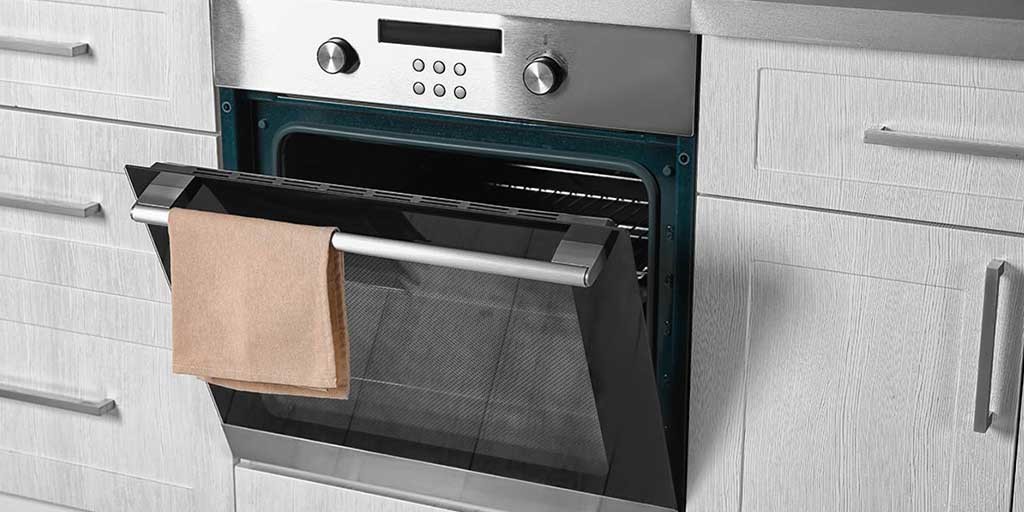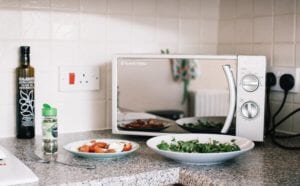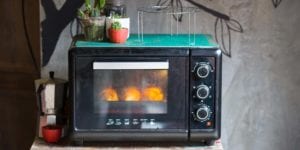Convection Oven vs. Conventional Oven: What Is the Difference?
Even a kitchen novice will be familiar with an oven, but not everyone is aware of the distinctions between a conventional and a convection oven. We wanted to use this article to break down the differences, as each can have a substantial impact on how you cook your food. Read on as we offer some important definitions and carefully consider the advantages and disadvantages of each style so that when the time comes for you to buy or upgrade your oven, you will know which one you want.
The Basics: Conventional versus Convection
First things first: let’s straighten out conventional versus convection ovens. The conventional oven is the more traditional design and simply envelopes whatever you put inside of it with hot air. Meanwhile, the convection oven takes the process a step further by, as you probably guessed, relying on the principle of convection, which forces the movement of hotter, less dense air upward, causing colder, denser air to sink under the influence of gravity, resulting in a transfer of heat through a circulation of the air. While there are many advantages to the convection oven, they are not perfect, so let’s look a little bit closer at the cooking process in both cases.
The source of this circulation is the key difference: the convection oven has a fan, which the conventional oven does not. Convection ovens also have an exhaust system to help circulate the hot air around the oven chamber. The exhaust system also removes moisture created in the cooking process, so if you want a crispy top to your baked mac and cheese, the convection oven should be more efficient at that too. So, while they may appear to be the same in looks, size and weight, that simple fan and exhaust system make a whole world of difference in the way the oven cooks.
Electric or Gas?
It’s fair to say that most convection range cookers feature cooktop burners that are gas, which many people prefer, thanks to the relative ease of control of gas burners. Of course, as with all advances in technology, we should mention the induction cooktops that come with the latest range models, which offer (almost) instant hot and cold functions. Beyond the burners, though, electric convection ovens are more common than the gas convection ovens. Why? Because when you light a gas flame in the oven and switch on a fan to circulate the air, the danger is that the fan could blow out the flame. That can lead to all sorts of complications, including carbon monoxide poisoning.
Electric convection ovens don’t have a flame, so all the fan does is circulate hot air. It means that the fan isn’t compromised to accommodate the dangers of a flame. Some newer models of gas convection ovens, however, have smaller fans strategically placed in the oven to avoid that danger. This means that gas convection ovens can now be as safe as electric convection ovens. Fans are typically located centrally in the oven for a more even cook and better heat circulation. These factors, combined with the fact that convection ovens can head faster than conventional counterparts, can result in faster cook times and lower energy bills.
In the case of the conventional oven, the heat is generated from an element if it’s electric or a flame, which is typically located at the bottom of the oven, if it’s gas. When you switch it on, the flame or element heat up the chamber of the stove as the heat rises, pushing the colder air to the bottom; if you have a conventional oven, you will notice this process by the fact that the hottest part of the oven, the bit where everything cooks quicker, is located on the top shelf.
Convection vs. Conventional: How Does it affect my Cooking?
Most manufacturers today give consumers the option of being able to switch the convection function on or off, depending on what you’re cooking. It may be that you have this function on your oven already, especially if it’s a newer model. This is a beneficial option because, while convection ovens have their advantages, they are not always the best choice. Some of the key perks of cooking with convection include:
Reduced Cooking Time
A conventional oven heats the whole chamber, so it can take a little time for the oven to reach temperature and then also regain that temperature when we add in a chilled or frozen food item. The convection also needs a little time to arrive at the correct temperature, but it does so much quicker and can also rebound in temperature more promptly. This is great news if you need something cooked in double quick time.
Even Baking
Conventional oven often cook unevenly. The tell-tale signs of an uneven bake are that the food looks cooked on the top, but it’s a different story on the base. You can remedy this manually by rotating dishes between the shelves of the oven as they bake, but this still doesn’t eliminate hot and cold spots. As a result, you’ll be watching the cooking process like a hawk, timing when it went in and when the dish needs rotating or lowering/raising to a higher shelf. In a convection oven, the process is a lot simpler. Because of the even distribution of heat, the dishes cook evenly, front to back and top to bottom, meaning that you can take your coffee into the garden and read a magazine, while the convection oven does the hard work for you.
Energy Efficiency
Convection ovens are more efficient when it comes to the energy they use. Because the oven heats up quicker, and the cooking process is more even, the food should cook faster. In a conventional oven, the heat isn’t distributed evenly, resulting in you opening the oven door to rotate the food and shuffle dishes from the top to the bottom shelf. Every time the door opens, the oven loses temperature, resulting in more energy used to bring it back to the correct heat. If you compare the two types of oven, the energy they use is similar, but the savings come in the efficiency of the convection oven. In fact, a lot of manufacturers recommend that you lower the settings on a convection oven by around 25 degrees or so, to accommodate faster cooking times.
Considerations for Convection Cooking
While convection ovens have a lot of advantages over conventional ovens, it is important to note that they are not perfect. Here are some elements to keep in mind:
Sometimes Conventional is Better
There are times when a convection oven won’t surpass a traditional oven. Take baking for example: when you want a steady, even rise, a convection oven could be too efficient for the job. With a convection oven, the heat circulates evenly, and the exhaust system removes the moisture, resulting in a cake that is cooked well on the outside but is still raw in the middle. That’s because baking requires moisture retention within the cooking process; otherwise the cake will be dry. A conventional oven is excellent at this because the moisture is trapped in the oven chamber, resulting in an even rise, and great cakes and bread. Convection ovens tend to change the texture of the food too. When you remove the moisture from a loaf of bread, the cooking process changes the composition of the dough. The type of food you cook in the oven is essential when it comes to the kind of oven you have. It stands to reason that there are going to be situations when the conventional oven will outperform the convection oven hands down.
You Still Need to Check Your Food
While they might not need as much monitoring as a conventional oven, you still need to check on your dish frequently during the cooking process, especially at the end because the convection oven has the potential of cooking your food much faster than you expect. It‘s better to use the light and check through the glass viewing panel rather than open the door because this upsets the circulation of the air in the oven and with it, the convection process. It could result in an uneven bake, and prolonged cooking times. That isn’t good for energy consumption, mainly if you bought a convection oven for that reason.
Don’t Overfill the Oven
It is also a good idea not to overfill the oven. If you think of the stove in the same way that your HVAC system works, air needs to circulate freely for the HVAC to do its job effectively. Your convection oven is the same. For the food to cook evenly, the hot air has to move freely in the oven chamber. All this space restriction makes a conventional oven a better bet if you’re catering for more significant numbers of people, say at a dinner party. And this is an important point to make: The energy savings of a convection oven can be negated by the reduced capacity, resulting in a longer cook time, and more hassle for you. Try to use dishes that allow the air to circulate freely around the food. The conventional oven isn’t as fussy. You can use whatever you have to hand, within reason. It could save you going out and buying a whole new range of baking dishes.
Check Your Settings
Some of the newer convection models have adjustable fan speeds for different cooking methods. If you are baking bread or a cake, you will want the fan speed to be slower, allowing for more moisture in the air and a slower, more even bake. If, however, you’re cooking a roast dinner and you want the meat crispy on the outside, a higher fan speed would be best to remove the moisture and crisp the surface of the meat.
Convection Oven vs. Conventional Oven: Which Is the Best?
We think the merits of each type of ovens suggest that you should look at both. If you are in the market for a new oven, seriously consider buying one with a conventional and convection setting. That way you get the best of both options, and truly modern ovens are so advanced that there shouldn’t have to be a choice between the two.
Of course, we recognize that cost is a significant factor when considering your purchase options and it may be that you can’t stretch to a top of the range oven, so then it boils down to your own personal preference. Are you a keen baker, someone who bakes bread regularly and so, wants an even rise? Or are you all about the technology, the efficiency, and the running costs? Which camp you fall into depends on what you’re looking for from an oven, however, if you could stretch to an oven that allows both conventional and convection, well, you could have your cake and eat it too.




